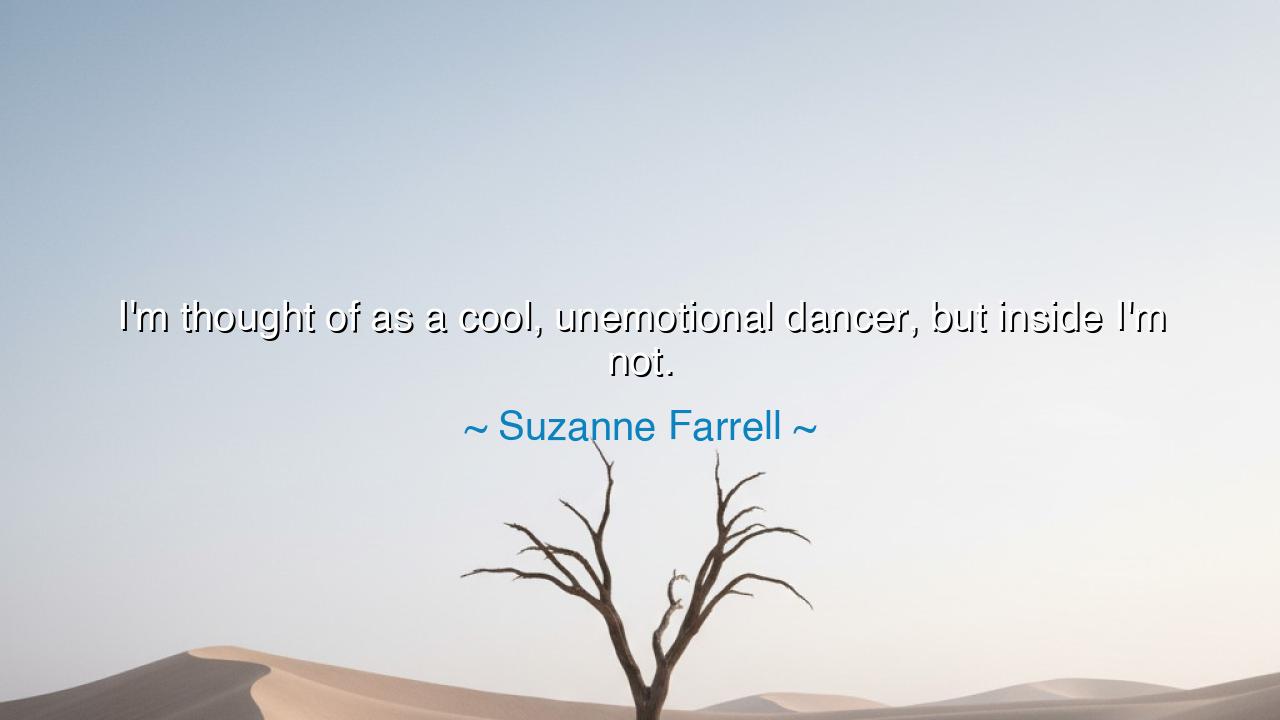
I'm thought of as a cool, unemotional dancer, but inside I'm not.






On the Quiet Fire Beneath Grace
When Suzanne Farrell said, “I’m thought of as a cool, unemotional dancer, but inside I’m not,” she revealed a truth that echoes far beyond the world of ballet — the eternal divide between appearance and essence, between what the world sees and what the heart feels. Her words are not only about dance; they are about the human condition. They remind us that serenity is often a veil for passion, that composure can conceal storm, and that the truest art — like the truest soul — burns most fiercely beneath the stillest surface.
Suzanne Farrell, one of the greatest ballerinas of the twentieth century, was known for her precision, poise, and almost otherworldly calm upon the stage. Audiences saw a dancer of perfect control — a swan of ice and grace, gliding through the air as if untouchable by mortal emotion. But within, as her words reveal, there was fire — feeling, vulnerability, and a heart alive with the ache of expression. In this, Farrell teaches that what appears cool on the outside may, in truth, be born from great heat within. For it takes passion to discipline oneself into stillness, and deep emotion to move so seamlessly that others see only perfection, not struggle.
This paradox — the coexistence of control and intensity — has been known since ancient times. The samurai of Japan, whose art was the sword, trained their minds to remain calm as still water even in the face of death. To the untrained eye, they seemed unemotional, detached; yet within them roared the power of total devotion. So too with the Stoic philosophers, like Marcus Aurelius, who taught that a man should meet chaos with composure, not because he feels nothing, but because he has mastered the tempest within. Suzanne Farrell belongs to this lineage of artists and warriors: those who conceal the immensity of their passion behind the mask of tranquility, knowing that to express beauty purely, one must first command the self.
Her words remind us that art is a sacred paradox. The dancer must suffer to move effortlessly; the poet must wrestle with despair to write clearly of hope; the painter must know darkness to bring forth light. Farrell’s so-called “coolness” was not the absence of emotion — it was emotion distilled, refined, and focused into grace. The stage demanded restraint, but restraint did not mean emptiness. Beneath every turn, every leap, every trembling balance point, there pulsed the deep, human desire to be understood. This is what makes her statement so profoundly human: she was not cold, but burning quietly beneath her own brilliance.
Consider, too, the story of Mikhail Baryshnikov, another legend of the dance, who once said that discipline is the highest form of freedom. His performances were a storm of control — every muscle responding to will, every gesture seemingly effortless. Yet behind that calm mastery lay years of pain, doubt, and relentless pursuit of truth through movement. Like Farrell, he knew that art is not a mirror of emotion, but its vessel — that to communicate feeling powerfully, the artist must first transform it. It is not the wild heart that creates immortal art, but the disciplined one that channels its wildness into form.
Suzanne Farrell’s statement carries a lesson for all who live behind masks of grace or calm. In a world that prizes display over depth, she reminds us that unseen emotion is not lesser — it is sacred. The quiet soul, the measured hand, the soft-spoken heart — these, too, burn with power. We must learn not to mistake composure for emptiness, nor stillness for coldness. For the world’s most profound beauty often arises from those who feel deeply but express it gently, those who let their fire move unseen beneath their cool surface.
The lesson, then, is this: Do not be deceived by appearances, neither in yourself nor in others. When the world calls you distant or unemotional, remember that depth often hides beneath the calm of your own being. Let your emotions be your secret fuel, not your public storm. Like Farrell, let your art — whatever form it takes — speak for the feelings your words cannot. And if you are the observer, remember to look beyond the surface. The soul’s true heat is rarely visible; it glows behind the eyes, between gestures, within silences.
Thus, Suzanne Farrell’s quiet confession becomes a timeless teaching. To be calm is not to be cold, and to appear serene is not to lack passion. The dancer’s stillness is the dancer’s strength; the calm face hides a universe in motion. In the end, this is the highest art of life itself — to feel deeply, yet walk in grace; to burn brightly, yet move with poise; to be aflame within, yet appear like still water to the world. For such is the way of the master, and such is the secret of the soul that dances unseen.






AAdministratorAdministrator
Welcome, honored guests. Please leave a comment, we will respond soon